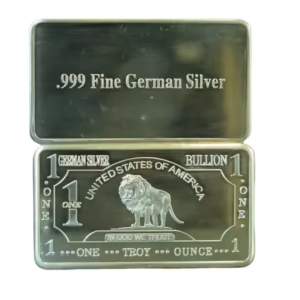german silver vs normal silver
1. What Are German Silver and Normal Silver Made Of?
German Silver, also known as Nickel Silver, is a silver-looking alloy that contains no real silver. Instead, it is made from a mix of copper (50-60%), zinc (20-30%), and nickel (10-25%). Due to its silvery shine, it is often used as a cheaper alternative to real silver.
On the other hand, Normal Silver refers to Sterling Silver (92.5% silver + 7.5% copper) or Fine Silver (99.9% pure silver). Unlike German Silver, these contain real silver, making them more valuable and sought-after for jewelry and investments.
Key Takeaways:
- German Silver = Copper + Zinc + Nickel (No Silver)
- Sterling Silver = 92.5% Silver + 7.5% Copper
- Fine Silver = 99.9% Pure Silver
If you’re buying silver jewelry or utensils, always check the hallmark—German Silver won’t have “925” or “999” stamps.


2. Appearance & Durability: Which Silver Lasts Longer?
German Silver has a metallic shine similar to real silver but tends to look slightly duller over time. It is stronger and more corrosion-resistant than pure silver, making it ideal for items like musical instruments and decorative pieces.
Sterling Silver, while more lustrous, is softer and prone to scratches and tarnish. However, it can be polished back to its original shine. Fine Silver, being the purest, is the most delicate and requires careful handling.
Durability Comparison:
- German Silver → More durable, less tarnish
- Sterling Silver → Elegant but requires maintenance
- Fine Silver → Softest, best for collectors
For everyday wear, Sterling Silver is a good balance, while German Silver works for budget-friendly options.
3. German Silver vs. Sterling Silver: Which One is Worth the Money?
German Silver is far cheaper because it contains no real silver. It’s a great choice for affordable jewelry, cutlery, and decor. However, it does not hold value like real silver.
Sterling Silver and Fine Silver, being precious metals, have higher resale value. They are often used in fine jewelry, luxury tableware, and bullion investments.
Price Comparison:
- German Silver → Budget-friendly, no investment value
- Sterling Silver → Mid-range, good for jewelry
- Fine Silver → Expensive, best for collectors
If you want long-term value, go for Sterling or Fine Silver. For cost-effective alternatives, German Silver is fine.
4. Skin Safety: Can German Silver Cause Allergies?
One major drawback of German Silver is its nickel content, which can cause skin irritation and allergies in some people. If you have sensitive skin, wearing German Silver jewelry may lead to redness or rashes.
Sterling Silver (if nickel-free) and Fine Silver are hypoallergenic, making them safer for long-term wear. Always check if the alloy contains nickel before purchasing.
Skin-Friendly Options:
- German Silver → May cause allergies
- Sterling Silver (nickel-free) → Safe for most people
- Fine Silver → 100% hypoallergenic
For sensitive skin, stick to Sterling or Fine Silver.
5. How to Spot Fake Silver: German Silver vs. Real Silver
Since German Silver mimics real silver, here’s how to identify genuine silver:
- Check Hallmarks – Look for “925” (Sterling) or “999” (Fine Silver). German Silver has no silver markings.
- Magnet Test – German Silver may be slightly magnetic due to nickel; real silver is not.
- Acid Test – Silver testing kits confirm authenticity.
- Tarnish Test – Real silver tarnishes slowly, while German Silver may corrode differently.
Always buy from trusted sellers with certifications.
6. German Silver vs. Sterling Silver: Which is Best for Jewelry & Decor?
- German Silver → Best for cost-effective jewelry, musical instruments, and decorative items.
- Sterling Silver → Ideal for high-quality jewelry, silverware, and gifts.
- Fine Silver → Perfect for collectors and investors.
Final Verdict:
- For affordability → German Silver
- For elegance & value → Sterling Silver
- For purity & investment → Fine Silver
Choose based on budget, purpose, and skin sensitivity!